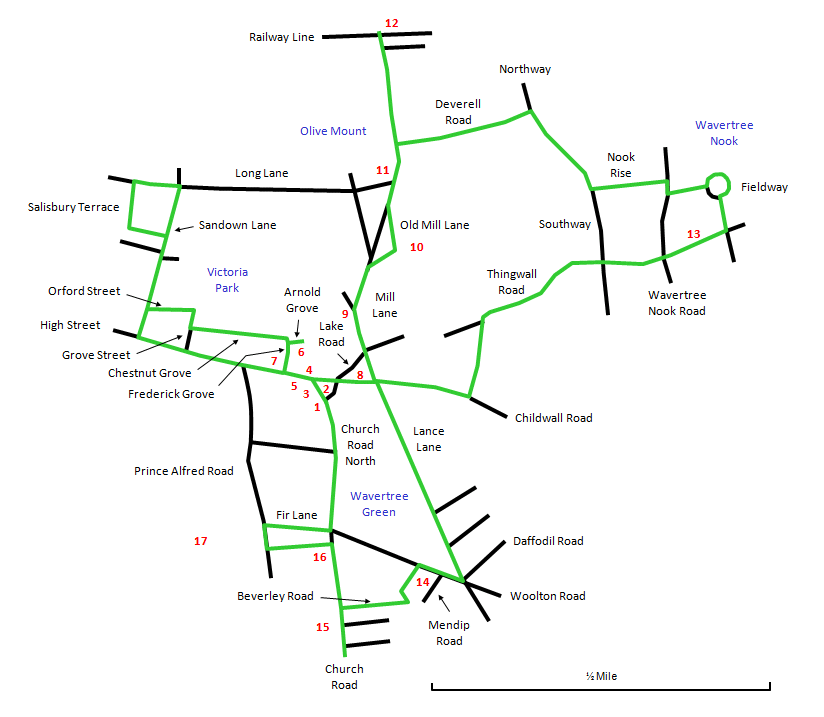| Historic Wavertree |  |
|||
| Historic Wavertree |  |
|||
This is an amble of about 4½ miles (7½ km) around the historically interesting sights of Wavertree, and there are quite a few! That I have only recently realised the full extent to which this is true, despite living only a few miles away, is largely down to Mike Chitty's fascinating site Discovering Historic Wavertree. I am indebted to him for a lot of the information here and especially in the Wavertree section of merseySights. Hard surfaces are hard on the feet and the walk can be split up into shorter circuits in obvious ways. Choose a nice sunny day especially when autumn colours abound. There are plenty of pubs and bars in Wavertree Villlage should you be in need of refreshments. |
 |
Start in Wavertree Village by the Coffee House pub [1] with its row of tiny adjoining old cottages and head off towards the Picton Clock tower [2]. |
You pass 17th century White Cottage [3] on the left. When you reach the roundabout, notice the imposing Georgian-style Lamb pub [4] in front of you. |
Turn left along the High Street and immediately on your left is Liverpool's only surviving Georgian bow-fronted shop [5] (straight out of Dickens). Cross over the road and make for a narrow gap to the right of the betting shop that opens out into Frederick Grove. A few houses along on the right is Arnold Grove, No. 12 of which [6] is the modest terraced house where Beatle George Harrison was born. |
Return along Arnold Grove and do a quick right and left into Chestnut Grove. This is the start of Victoria Park, an pleasant and secluded area of early 19th century housing. At the end do another right and left into Orford Street, one of the most attractive streets in Wavertree Village, where every house is a listed building, I understand. Continue your tour of Victoria Park by turning right into Sandown Lane by the Edinburgh pub. Continue to the end, noting stuccoed Sandown Terrace on the right. Turn left into Long Lane and left again into Salisbury Terrace, another charming row of old houses. At the end is a narrow road to the left that will return you to Sandown Lane. Head back to the High Street and turn left. On the left, just before the point where you earlier left the High Street, is the Cock and Bottle pub, adjoining which on the right is 'The Smallest House in England' [7] (now part of the pub). |
Continue straight along the High Street in the direction of Childwall Road. Just after the clock tower is a little triangular green on the left, where you will find the 18th century Wavertree Lock-up [8]. Cross the green and head up Mill Lane. Just before North Drive branches off to the left is the Monks' Well [9], the base of which is one of the very few examples of mediaeval stonework surviving in Liverpool. |
Continue along Mill Lane as it rises uphill. This is the start of the area known as Olive Mount. Turn off on the right into Old Mill Lane. Opposite where this bends to the left is Olive Mount mansion [10] (currently an NHS premises), one of the earliest of many in the area, not all of them still with us. Further along is one of the old outhouses of Wavertree Lodge, now among those demolished. |
Continue back onto Mill Lane and follow it up the hill. At the highest point on the left, just after Long Lane, is Sandy Knowe [11], the house Liverpool architect John Picton built for himself. Follow the road as far as the Olive Mount Railway Cutting [12] and peer into its depths trying to imagine how impressive it must have been at half its present width, as it was in George Stephenson's day. Now turn back until you reach Deverell Road on the left. Follow this to the end and turn right onto Northway. |
As you approach Nook Rise on the left, the architecture suddenly changes. This is the start of Wavertree Garden Suburb. To explore this delightful area follow Nook Rise to Wavertree Nook Road and cross over to the right to locate a narrow path between the houses starting at a couple of bollards. Follow this to the circular Fieldway with Fieldway Green in front of you. Turn left and do a three-quarter circuit before heading off towards Thingwall Road. |
Turn right onto Thingwall Road and note a short way along on the right a pair of unusually designed early 19th century stone cottages that have been converted for use as Wavertree Garden Suburb Institute[13]. Follow Thingwall Road as far as Childwall Road, a pleasant, leafy suburban way that meanders along the original route of this ancient byway. Go right at Childwall Road and then turn left into Lance Lane. At the end of Lance Lane (OK, it is a bit of a long stretch , this one), turn sharp right into Woolton Road. You will pass Mendip Road on the left and then look out for a footpath signed to the left between the houses. This is an ancient right-of-way that originally lead to Wavertree Windmill at the other end. Along here you pass the secluded early 18th century Mill Cottages [14] before joining Beverley Road. |
At the end of Beverley Road, turn left along Church Road to have a look at the undoubtedly imposing Bluecoat School [15]. Turn back the way you came to visit the Georgian Holy Trinity Church [16]. |
Walk through the graveyard to the right of the church with the huge area of Wavertree Playground and a distant view of the Anglical cathedral in front of you. Return to Church Road via Prince Alfred Road and Fir Lane, then turn left to reach your starting point at the Coffee House. |